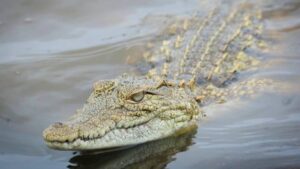
By:Annakleta Haikera
Mukwe Constituency Councillor Damian Maghambayi says40 crocodiles offered by the Ministry of Environment and Tourism on Wednesday for public sale as part of its human-wildlife conflict management are not enough.
Environment Minister Pohamba Shifeta said on Thursday it would auction off dozens of crocodiles and deliver more permits to hunt the big reptiles, whose growing population is leading to more attacks on people.
Shifeta said the move comes as crocodile numbers have grown to a point where they are no longer sustainable.
“We have targeted different areas where the crocodile population exceeds the carrying capacity and moving onto the shore where they start to attack people,” Shifeta said.
The Ministry said that 40 crocodiles would be captured from rivers in the northeastern, wildlife-rich regions of Kavango and Zambezi — and auctioned off.
Shifeta said they would be sold to anyone who could prove they have suitable habitats for the crocodiles, and who have proper export papers.
“We are also looking at where the human attacks take place in conservancies and will increase their trophy quota, we might double it,” Shifeta said.
The decision was based on a study of the reptile population after an increase in reports of crocodiles wading into inhabited areas, he said.
The Ministry has since 2019 paid more than 2.3 million Namibian dollars ($125,000) in compensation to families affected by crocodile attacks, some of which were fatal, the Minister said.
The sum included 14 payouts for injuries to people, as well as compensation for the loss of livestock.
Bidding for the crocodiles is set to begin on July 17 and sales will be repeated periodically to control population numbers.
Meanwhile, Mukwe Constituency Councillor Maghambayi welcomed the Ministry’s gesture as good but not sufficient.
He said that Mukwe is one of the areas prone to crocodile attacks, but considering the fact that the Kavango river is 400 km long and the life expectancy of crocodiles is roughly 100 to 120 years, some crocodiles were born long ago and are still alive.
“We have to look for a sustainable solution to use our resources to compensate the community from human-wildlife conflict,” he told The Villager.
Mughayambi said to eliminate the threat posed by crocodiles is to harvest them in the same way seals are harvested at the Walvis Bay coast, as a way also to save the fish in the river from being depleted.
“The number of crocodiles is increasing everyday. We want to create a food chain, so that the Ministry could allow people to hunt some of those crocodiles,” he said.
Mughayambi called on the Ministry to consider every village to have a crocodile farm for them to benefit from their own resources.
“We should also establish how many crocodiles we have so that we can have our own border and move away from being funded by the Namibian Game Products Trust Fund.”
According to research, there are around 11,000 Nile crocodiles in Namibia’s north-eastern rivers and floodplains.
Zambezi region farmers representative, Dobson Kwala was of the view that the number the Ministry chose was arbitrary as the animal kingdom has trouble-animals and when decided to decrease the population of animals, it should not just be because their population is high, but the decision should speak to the threat they pose to human life.
Kwala further said that age of the animal plays a role, as it is how the skins of crocodiles get marketed.
“Now there is a certain age that is reasonable on the size that is required for slaughtering so that the skin is marketable and soft enough to be turned into any form,” he said.
“The putting down should be in line with the market available for supply of the meatm skeleton and skin; sometimes you find out that there are people that want to go make some replica of a crocodile and put it in the museum,” he said.
Modestus Kasoma, a resident who lives with a family member who has survived a crocodile attack, told The Villager that there are many strategies the Ministry can do to save more lives and also compensate the families of those that have lost their loved ones and at the same time those that have survived.
“The Ministry can look for investors who are available to buy up all the 40 crocodiles and then give the money to those that have been attacked but have survived to start up their own business. Many of these people need medical attention too, but don’t have money for proper treatment,” Kasoma said.
Approached for comment, Environment Ministry spokesperson Romeo Muyunda stated the sale of the crocodiles is meant to minimise incidents of human-wildlife conflict, as well as mitigate the impact of crocodile conflicts on communities.
“This is also in line with the recommendation made at the recently ended conference on human-wildlife conflict management for the ministry to reduce the number of crocodiles in the affected regions,” he noted.
He further said that since 2019, the Ministry has paid offset amounts of over N$2.3 million for losses caused by crocodiles. This includes N$575,000 for 195 cases of livestock losses and N$140,000 for 14 cases of injuries to people and over N$1.6 million for human lives lost.
Muyunda said over the years, Namibia has experienced a remarkable recovery of wildlife populations as a result of good conservation methods and this has placed the country as a global leader in conservation.
“However, this has also resulted in increased cases of human-wildlife conflict as the majority of the country’s wildlife exist outside national parks. The north eastern regions of Kavango West, East and Zambezi continue to experience crocodile attacks on people and their livestock,” Muyunda said.









Comments